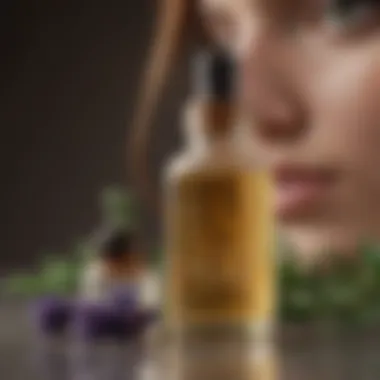Craft Your Own Skincare: The Art of Homemade Beauty


Intro
Homemade skin care has gained significant traction in recent years. Many individuals seek alternatives to commercial products filled with synthetic ingredients. With personalized approaches, enthusiasts are changing their beauty routines. This exploration looks into the intricate aspects of creating effective, nourishing skin care at home.
The upcoming sections will cover various dimensions of homemade skin care. We will highlight the science and art behind it, discuss the importance of knowing one’s skin type, and provide detailed recipes. By understanding the benefits of various natural ingredients, readers can feel empowered to make informed decisions about what to put on their skin.
Additionally, we will address safety considerations and potential risks involved with DIY skin care. This ensures that readers are not just creative but also responsible in their beauty journey.
Effective skin care goes beyond just makeup or aesthetics. It delves into health and well-being. Whether you are new to this realm or a seasoned creator, this article promises to deepen your understanding and enhance your practices.
As we start, let’s first investigate current Fashion Trends in the homemade skincare space.
Fashion Trends
This section explores trends shaping the landscape of homemade skin care. Different seasons often dictate what ingredients are popular. Not only that, but social media influencers play a vital role in these trends, inspiring many to embrace natural products.
Seasonal Styles
Just as fashion has seasonal trends, so does skin care. Seasonal styles dictate the type of ingredients people should use.
- Spring: Light and refreshing products using ingredients like cucumber or rosewater.
- Summer: Focus on hydration with aloe vera and coconut oil, ideal for hot weather.
- Fall: Nourishing elements like pumpkin and cinnamon bring warmth during cool days.
- Winter: Moisturizing ingredients such as shea butter and honey help combat dryness.
Understanding this cycle allows individuals to cultivate a more effective and relevant skincare routine.
Influencer Inspirations
Social media platforms are filled with content from beauty influencers who promote homemade skin care. They share recipes, demonstrate techniques, and highlight the benefits of various ingredients. Influencers often focus on:
- Creating eco-friendly beauty routines.
- Using sustainable sourcing for ingredients.
- Personalizing skin care to suit individual needs.
By tuning into these inspirations, readers can gain insights and motivation to explore their skin care creations further.
The shift toward homemade skin care is not just a trend; it reflects deeper cultural values around health and sustainability.
This awareness also fosters a sense of community among those engaged in homemade beauty practices. As we proceed, the next section will delve into practical Beauty Tips that can enhance your DIY endeavors.
Prologue to Homemade Skin Care
Homemade skin care offers an compelling alternative to commercial products. In a market saturated with synthetic solutions that claim to deliver results, many individuals are seeking more natural, simpler options. The practice of crafting one's own skin care products has been around for centuries, but recent trends show a significant resurgence. This article aims to explore the importance of understanding homemade skin care by highlighting its benefits, ingredients, and crafting techniques.
The Rise of Natural Beauty
The natural beauty movement has gained momentum in recent years. More people are recognizing the potential harms of chemicals often found in mainstream skin care products. Factors such as allergic reactions and skin irritations lead consumers to look for alternatives that afford them greater control over what they apply to their skin.
By using homemade skin care products, individuals can avoid harmful preservatives, fragrances, and artificial colors. This empowerment fosters a deeper connection to one's beauty routine and allows for customization in accordance with individual preferences and skin conditions. Natural ingredients, oftentimes found in one's pantry, serve to nourish and rejuvenate the skin.
As the focus on sustainability increases, the rise of homemade skin care aligns with environmentally conscious practices. It not only reduces waste from packaging but also diminishes the carbon footprint associated with manufacturing and distribution processes of commercial products. Together, these factors contribute to the broader trend towards a more holistic approach to beauty.
Benefits of Homemade Skin Care Products
Creating homemade skin care products brings multiple advantages to users. Here are some notable benefits:
- Customization: Each person has unique skin concerns, from dryness to sensitivity. Homemade products can be tailored accordingly to address specific needs and preferences.
- Quality Control: By sourcing ingredients directly, consumers have more transparency over what goes into their skin care. This helps to eliminate the guesswork or uncertainty that often accompanies product labels.
- Affordability: Many ingredients used in homemade formulations are cost-effective, which can significantly reduce overall beauty expenditures.
- Freshness: Homemade products generally do not contain preservatives, making them fresher compared to their store-bought counterparts. This freshness translates into more potent benefits for the skin.
- Educational Experience: The act of making one’s own products can enhance understanding of how different ingredients interact and the best practices for skin care.
"Homemade skin care is not just a trend; it's a profound way to connect health, nature, and personal expression."
In summary, homemade skin care offers a refreshing alternative that combines personal wellness with self-empowerment. Awareness of one’s skin type, preferred ingredients, and the crafting process enables individuals to embark on a skincare journey that is both satisfying and beneficial.


Essential Ingredients for Skin Care
Understanding Essential Ingredients for Skin Care is crucial in the journey of crafting effective homemade products. The right ingredients can enhance skin health, target specific concerns, and offer various benefits. This section will detail key elements, their advantages, and considerations to keep in mind when selecting ingredients for homemade skincare.
Carrier Oils and Their Properties
Carrier oils form the foundation of many homemade skincare recipes. They dilute essential oils and provide a moisturizing base. Common oils include jojoba, almond, and coconut. Each oil has unique properties that suit different skin types.
- Jojoba Oil: Mimics skin's natural oils, ideal for all skin types, especially oily skin.
- Sweet Almond Oil: Rich in vitamins, great for dry skin and acts as a great moisturizer.
- Coconut Oil: Antimicrobial properties make it useful for acne-prone skin.
Choosing the right carrier oil affects the absorption and efficacy of the final product.
Essential Oils: Benefits and Risks
Essential oils are concentrated plant extracts, known for their aromatic properties and potential skincare benefits. They can provide various effects based on their source. For example, lavender oil is calming, while tea tree oil is known for its antibacterial properties. However, essential oils can also pose risks, including skin irritation or allergic reactions. Always dilute them in a carrier oil and conduct a patch test before full application.
- Benefits: Aroma therapies, healing properties, and natural fragrance.
- Risks: Skin sensitivity, volatile reactions, and the need for proper dilution.
"Essential oils, when used wisely, can enhance your skincare regimen significantly."
Natural Exfoliants and Their Uses
Exfoliation is key for maintaining smooth skin. Natural exfoliants such as sugar, coffee grounds, and oatmeal can effectively slough off dead skin cells without harsh chemicals. Sugar can moisturize while removing impurities. Coffee grounds are not only a good scrub but also rich in antioxidants. Oatmeal soothes skin while providing a gentle exfoliation.
- Sugar: Best for the body; provides moisture.
- Coffee Grounds: Good for all-over body scrubs, improving blood circulation.
- Oatmeal: Excellent for sensitive skin, effective in soothing irritation.
Botanicals and Their Skin Benefits
Botanical ingredients in homemade skincare possess numerous benefits due to their nutritional value. Ingredients like aloe vera, chamomile, and green tea offer skin-soothing properties and antioxidants. Aloe vera hydrates and calms irritated skin. Chamomile acts as an anti-inflammatory agent, while green tea provides protection against sun damage.
- Aloe Vera: Moisturizes and prevents breakouts.
- Chamomile: Soothes skin irritation and reduces redness.
- Green Tea: Fights free radicals and improves skin elasticity.
Incorporating these botanicals into skincare formulations can lead to significant improvements in skin quality.
Understanding Your Skin Type
Understanding your skin type is crucial for anyone interested in homemade skin care. Identifying your skin's unique needs ensures the effectiveness of your crafted products. By comprehending these differences, you can select ingredients that offer the most benefits, prevent adverse reactions, and optimize overall skin health. This knowledge allows you to formulate treatments that cater to your specific concerns, promoting a more personalized and efficient skin care routine.
Identifying Oily, Dry, and Combination Skin
Oily skin is characterized by an excess of sebum, often leading to a shiny appearance and a tendency for breakouts. Individuals with oily skin may notice larger pores and may benefit from ingredients like witch hazel or tea tree oil, which help manage oil production and inflammation.
Dry skin, conversely, lacks moisture and can feel tight, rough, and sometimes flaky. Those with dry skin often need nourishing ingredients such as coconut oil or shea butter, which provide hydration and improve skin texture.
Combination skin shows traits of both oily and dry skin types. Commonly, it presents oiliness on the forehead, nose, and chin while remaining dry on the cheeks. This skin type requires a balanced approach, utilizing both hydrating and oil-controlling ingredients. Recognizing these characteristics is the first step in customizing your skin care routine.
Sensitive Skin: Special Considerations
Sensitive skin necessitates careful handling. It can react adversely to various products, leading to redness, irritation, or even allergic responses. For individuals with sensitive skin, the use of gentle, hypoallergenic ingredients is paramount. Look for non-comedogenic oils like jojoba oil or fragrance-free options to minimize the risk of reactions.
Patch testing is essential before trying any new homemade remedy. Apply a small amount of product to a discrete area and observe for 24 to 48 hours for any adverse effects. Being mindful of the ingredients you choose will help in avoiding potential irritants and ensure a more enjoyable experience with homemade skin care.
"Understanding your skin type is not just about knowing your skin; it is about making informed choices that enhance your beauty and well-being."
By consistently considering your unique skin type, your homemade skin care products can become truly personalized. This tailored approach ensures not only a more effective beauty regimen but also a better overall care plan for your skin.
Crafting Your Homemade Skin Care Products
The creation of homemade skin care products is a fascinating blend of art and science. It provides individuals the power to control what goes onto their skin. By crafting these products at home, it becomes easier to exclude unwanted chemicals and irritants common in commercial options. This practice not only fosters a deeper connection with one's skincare routine but also enhances the overall understanding of skin health.


When crafting homemade products, there are several important aspects to consider. First, knowledge of ingredients is vital. Each component brings specific properties that can benefit the skin. Furthermore, understanding the proper methods of combination ensures that these ingredients maximize their effectiveness. Additionally, products must be created with safety and preservation in mind. This approach helps avoid any potential reactions that might occur due to improper blending or storage.
The Basic Process of Creation
Creating homemade skin care products can be a straightforward process. Start with the formulation of a recipe that suits individual needs based on skin type and concerns. Here is a step-by-step approach to crafting these products:
- Choose Your Ingredients: Select the appropriate carrier oils, essential oils, and other natural additives based on skin requirements.
- Sanitize Your Tools: Before any mixing, ensure that everything from bowls to utensils is clean. This reduces the risk of contamination.
- Measure Accurately: Use precise measurements according to the chosen recipe. This accuracy ensures the best results and consistency in texture and effectiveness.
- Combine Ingredients: Blend ingredients following the recipe. Depending on the product, this might include melting, shaking, or stirring.
- Test the Product: Before full application, conduct a patch test to ensure the skin does not react adversely.
- Adjust Formulas: Based on personal experience or feedback from the patch test, make necessary adjustments. This could involve altering concentrations or trying different ingredients.
Storage and Preservation Techniques
After crafting homemade skincare items, proper storage is crucial for maximizing their effectiveness and lifespan. Here are several techniques to consider:
- Use Glass Containers: Opt for dark glass jars or bottles to store creations. This prevents light exposure that can degrade the quality of certain ingredients.
- Keep in the Fridge: For items containing fresh ingredients or high levels of water, refrigeration is advisable to maintain freshness.
- Limit Air Exposure: Use airtight containers to minimize oxidation, which can spoil products.
- Label Your Products: Marking the date of creation as well as ingredients helps in keeping track of freshness and safety.
Always remember to look for signs of spoilage, including changes in smell or color.
Popular Homemade Skin Care Recipes
Homemade skin care recipes are essential for those seeking personalized solutions. This section focuses on various recipes that cater to different skincare needs. The benefits of these recipes are numerous, including the use of natural ingredients, customization for specific skin types, and the absence of harmful chemicals found in many commercial products. When crafting these recipes, it is crucial to consider the unique properties of ingredients and how they interact with different skin types.
Facial Cleansers for Different Skin Types
Facial cleansers are the foundation of any skincare routine. The right cleanser can remove dirt, excess oils, and makeup without stripping the skin of its natural moisture. Here are some recipes suited for different skin types:
- Oily Skin: A combination of tea tree oil and aloe vera can reduce excess oils and fight acne. Mix one tablespoon of aloe vera gel with a few drops of tea tree oil.
- Dry Skin: A cleanser with honey and olive oil can hydrate. Mix two tablespoons of honey with one tablespoon of olive oil.
- Combination Skin: Use yogurt and cucumber to balance both oily and dry areas. Blend half a cucumber with one tablespoon of plain yogurt until smooth.
Each recipe here showcases the benefits of using simple, natural ingredients, aligning well with the principles of homemade skin care.
Moisturizers: Balancing Hydration
Moisturizers are critical to maintaining skin hydration. The right balance is necessary to ensure the skin feels supple and nourished. Consider these recipes:
- For Oily Skin: A lightweight moisturizer can be made with grapeseed oil and aloe vera. Mix two tablespoons of grapeseed oil with one tablespoon of aloe vera gel.
- For Dry Skin: Combine shea butter with almond oil for rich hydration. Melt two tablespoons of shea butter and add one tablespoon of almond oil.
- For Combination Skin: A blend of coconut oil and argan oil works well. Mix one tablespoon of coconut oil with half a tablespoon of argan oil.
These recipes provide hydration without clogging pores, thus addressing various skin care needs effectively.
Face Masks: Nourish and Revitalize
Face masks offer targeted benefits, allowing ingredients to penetrate deeply. These recipes can revitalize and nourish the skin:
- Hydrating Mask for Dry Skin: A mask made with avocado and honey can provide deep moisture. Mash one ripe avocado with one tablespoon of honey.
- Soothing Mask for Sensitive Skin: Combine oatmeal and yogurt to calm irritation. Mix one tablespoon of finely ground oatmeal with two tablespoons of yogurt.
- Brightening Mask: Use turmeric and milk for a brightening effect. Mix one teaspoon of turmeric powder with two tablespoons of milk.
Such masks can enhance the overall appearance of skin while catering to specific concerns like dryness or sensitivity.
Scrubs: Exfoliating for Smooth Skin
Exfoliation is vital for removing dead skin cells and promoting new cell growth. Homemade scrubs can be tailored to meet individual needs. Consider these examples:
- Sugar Scrub for All Skin Types: Combine sugar and coconut oil. Use one cup of sugar with half a cup of melted coconut oil for a gentle scrub.
- Coffee Scrub for Cellulite: Combine used coffee grounds with olive oil and sugar. Mix one cup of coffee grounds with half a cup of olive oil and one-third cup of sugar.
- Baking Soda Scrub for Oily Skin: Combine baking soda and water to create a paste. Use two tablespoons of baking soda with enough water to form a paste.
These scrubs, when used regularly, can improve skin texture and tone, offering a refreshing feel.
Making your own skin care products allows you to know exactly what you are putting on your skin. It offers control over the ingredients and can be more economical than store-bought options.
Safety and Efficacy Considerations
In the realm of homemade skin care, safety and efficacy are critical factors to consider. Customizing skincare products can be both rewarding and beneficial, but it presents certain risks. The potential for allergic reactions and skin irritations must be addressed. It's vital to create formulations that not only meet personal preferences but also align with skin health. Understanding these aspects ensures that individuals can enjoy the full advantage of homemade products while minimizing adverse effects.
Patch Testing for Allergies


Before applying any homemade skin care product extensively, patch testing is essential. This small, preliminary test can help identify any allergic reactions or irritations a person may have to specific ingredients. To perform a patch test, follow these steps:
- Select the product. Choose the homemade skincare formulation you wish to test.
- Apply a small amount. Place a tiny amount of the product on a discreet area of skin, such as the inside of the wrist or behind the ear.
- Observe for reactions. Wait 24 to 48 hours for any signs of redness, swelling, or itching.
If the area shows no adverse signs, the product is likely safe for broader use. If irritation occurs, the specific ingredient causing the allergy can be isolated and avoided in future formulations. This simple process enhances skin safety and promotes healthier skincare practices.
Understanding Ingredient Interactions
Another vital aspect of homemade skincare is recognizing how different ingredients interact with each other. Specific combinations can enhance the effectiveness of a product, while others may lead to unfavorable results. Here are key points to consider:
- Synergistic effects. Some ingredients, like vitamin C and vitamin E, work well together, boosting each other’s antioxidant properties.
- Antagonistic reactions. Conversely, combining products such as retinol with certain acids could lead to irritation.
- pH levels. Maintaining appropriate pH levels is essential. For example, the ideal pH for a facial cleanser is between 4.5 to 5.5, which is close to natural skin levels.
Understanding these interactions will enhance the overall efficacy and safety of homemade skin products. Always research each ingredient's properties and possible interactions.
"Knowledge is power. Knowing your ingredients leads to more effective and safer homemade skincare results."
By prioritizing safety and efficacy, homemade skin care can be an enriching experience that aligns perfectly with individual skin goals.
The Potential of Homemade Skin Care
Homemade skin care presents a unique opportunity to redefine beauty routines. This section explores numerous aspects that highlight why individuals are increasingly drawn to crafting skincare products at home. The potential benefits of homemade solutions extend beyond skin health; they embrace sustainability, personalization, and greater control over ingredients.
Sustainability and Eco-Friendly Practices
One of the most compelling arguments for opting homemade skin care revolves around sustainability. Many commercial products are packaged in single-use plastics, contributing to environmental waste. By creating skincare items at home, consumers can significantly reduce their carbon footprint. To facilitate this process, consider using the following eco-friendly practices:
- Reusing Containers: Glass jars and old product containers are excellent for storing homemade mixtures.
- Minimalist Ingredients: Focus on simple formulations with fewer ingredients that also reduce production waste.
- Organic Sourcing: Whenever possible, choose organic ingredients to cut down on pesticides and chemical fertilizers that harm ecosystems.
"Sustainable skincare is not just about the product; it is about the entire lifecycle, from ingredient sourcing to disposal."
Incorporating these practices does not merely enhance personal care routines. It supports a wider movement towards environmental consciousness. This shift is important for future generations, who must interact with the planet in ways that our current practices may already be jeopardizing.
A Personalized Approach to Skincare
Personalization stands as a pillar of homemade skin care. Each person’s skin possesses unique characteristics, requiring tailored solutions to address diverse needs. By making products at home, users can adjust formulations based on their individual preferences. Key advantages of this approach include:
- Custom Ingredients: Users can select components based on their specific skin types. For example, oily skin may benefit from tea tree oil, while dry skin might thrive with shea butter.
- No Harmful Additives: Commercial products often contain preservatives, artificial fragrances, and other synthetic chemicals that can trigger irritation. Homemade alternatives allow users to avoid these additives, opting instead for natural options like honey or aloe vera.
- Controlled Experimentation: A personalized approach also invites experimentation. Individuals can tweak existing recipes to find what works best for them. This process fosters a deeper understanding of one’s skin, leading to more effective care habits.
By understanding the unique needs of their skin, users can forge deeper connections with their skincare regimen. Such engagement empowers individuals to take control, thus enhancing overall satisfaction with their results.
Coupling sustainability with a personalized strategy sets the stage for a more conscious and tailored skincare journey. Exploring the potential of homemade skin care opens doors to innovation and a deeper appreciation for self-care.
The End: The Future of Skincare
As we look towards the future of skincare, there is a marked shift in how consumers approach their beauty routines. The growing awareness of ingredients and the desire for transparency have driven many to reconsider commercial products. No longer is it sufficient to trust advertisements or brand promises. The evolution we see in skincare reflects a greater understanding of both the body’s needs and the materials we use on our skin.
Reevaluating Commercial Products
Commercial skincare products have dominated the market for decades, often boasting complex formulations and packaging that promise miraculous results. However, many consumers are beginning to scrutinize these claims critically. They are increasingly aware of potential irritants, synthetic additives, and the environmental impact of mass production. Issues like animal testing and unethical sourcing also contribute to a growing distrust in commercial brands.
This scrutiny leads to a broader discussion about ingredient transparency. As consumers educate themselves on what goes into their skincare, they seek simplicity and authenticity. Products with long ingredient lists can be alarming, whereas homemade solutions often reveal fewer and more recognizable components.
"Consumers are no longer passive recipients of beauty norms; they are active participants in crafting what works for them."
Embracing Custom Solutions
Alongside the reevaluation of commercial products, the future of skincare is undoubtedly leaning towards personalization. Custom solutions allow individuals to tailor their skincare to their unique needs. Each person's skin is different, influenced by a range of factors from genetics to lifestyle. This necessitates a more nuanced approach to skincare.
Homemade skincare allows for this level of customization. Individuals can experiment with various ingredients that suit their skin type, such as using shea butter for dry skin or tea tree oil for acne. Moreover, the ability to modify recipes based on personal preferences offers empowerment.
Some key benefits of embracing custom solutions include:
- Targeted Treatments: Direct targeting of individual skin concerns with ingredients that provide maximum benefit.
- Ingredient Control: Full control over the composition of products, allowing avoidance of allergens and irritants.
- Cost-Effectiveness: Often, homemade skincare can be more economical, particularly when large quantities are prepared.
- Creative Expression: Crafting personalized skincare is a form of self-expression and encourages mindful consumption.
The future of skincare is evolving. It is reflective of a collective desire for authenticity, efficacy, and individuality. By reevaluating commercial products in favor of customized solutions, individuals not only care for their skin; they redefine their relationship with beauty.



